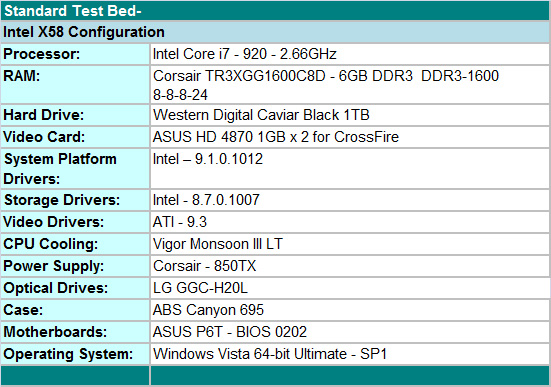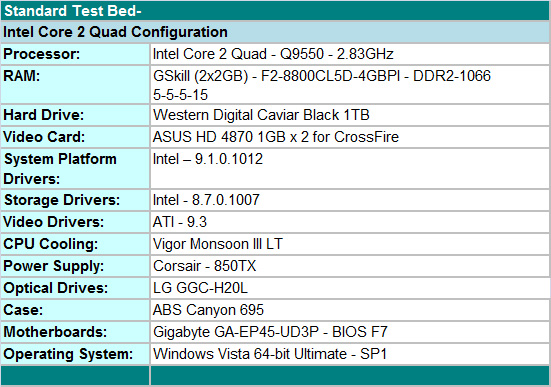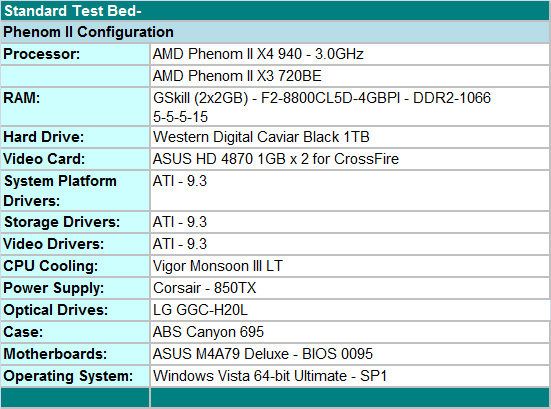Phenom II X3 720BE & CrossFire X Performance - Does it Compete?
by Gary Key on March 28, 2009 12:00 AM EST- Posted in
- Motherboards
Test Setup
Fortunately for us, during motherboard testing we test SLI or CrossFireX solutions extensively. However, we do not test the graphics cards in the same manner as we do in a GPU review. During motherboard testing, we focus on ensuring compatibility, identifying any layout problems, and checking performance deltas between motherboard chipsets. Instead of running absolute GPU intensive settings, we seek a balance of playable settings that ensures decent platform performance. This means reasonable resolutions and 2xAA/8xAF settings to keep the GPU from being a limiting factor where possible. We think these quality settings are fine for most users, especially in FPS games where the differences between 2xAA, 4xAA, or 8xAA are usually minimized due to the speed of the game.
We run our benchmarks at two of the most popular resolutions for new systems, which happen to be 1680x1050 and 1920x1200, although 1920x1080 is gaining traction quickly. We mention this now as our overview of CrossFireX performance will not have 2560x1600 at 4xAA/16xAF results or tri-card setups. The population of 30” monitors is rather small and except for Crysis, tri-card performance is usually worse or at best a break even experience compared to dual card performance with our mid-range setups. Consider this review a snapshot of CrossFireX performance with one particular GPU selection as we will not be looking at other ATI cards except the HD4870 1GB.
Our test systems today are based on similar components where possible. The Intel Core 2 Quad and AMD Phenom II platforms will satisfy the requirements of most enthusiasts looking for great performance from mid-range setups. We selected a “mid-range” Core i7 setup that is capable of both SLI and CrossFire to ensure platform consistency in future articles.



Our decision to go with a 790FX/SB750 combination on the AMD side is strictly based upon performance. The 790FX is about 3%~5% faster on average than comparable 790GX products in multi-GPU configurations. AMD continues to recommend the 790GX/SB750 as the platform of choice for the AM2+ and upcoming AM3 products. We disagree from a performance viewpoint; the 790FX/SB750 combination is simply the best choice in our opinion. Of course you will typically pay about $35~$40 or greater for the 790FX boards, but if you intend on running CrossFireX or benchmarking, we think it is worth the additional cost. We changed motherboards from our original DFI selection to the ASUS M4A79 Deluxe as we will be utilizing the M4A79T Deluxe in an upcoming DDR2/DDR3 memory comparison article.
On the Intel side, we decided to go with the P45 chipset as it offers a very balanced blend of performance and value. The Gigabyte GA-EP45-UD3P is a superb CrossFire capable motherboard that also happens to be one of the best overclocking S775 products around. The P45 offers dual PCI Express x8 operation in CrossFire mode compared to dual x16 on the 790FX, X48, and X58 boards. However, we did not notice any performance differences between dual x8 and dual x16 operation when comparing the P45 to the X48 in offline testing utilizing our resolutions and quality settings.
The i7 setup can be cost reduced easily without sacrificing any "real and perceivable" performance due to a motherboard and memory alternatives currently available in this market sector. If you are only interested in CrossFire capability on the X58, motherboard costs are now in the sub $200 range. The price of DDR3 has dropped dramatically this last month with very good DDR3-1333 6GB memory kits going for $90 or so now.
We selected the ASUS EAH4870 DK/HTDI/1GD5 video card. It is a non-reference design that offers improved thermals and acoustics over the standard HD4870 1GB cards on our board choices. We think if a user is going to run CrossFireX on one of these platforms, then the best possible performance choice is the HD4870 1GB, at least until the HD 4890 ships next week. Depending upon pricing on the HD 4870 1GB cards or upcoming HD 4890 cards, a 4870X2 might be a better choice for users wanting CrossFireX.
The WD Caviar Black 1TB is our hard drive of choice for storage purposes. LG’s Blu-ray playback capable drive fills in for optical duties. We purchased two of G.Skill's impressive DDR2-1100 4GB kits that operate at speeds up to DDR2-1240 on our boards with about 2.1V of VDimm. We used 4GB in our Phenom II and Core 2 Quad systems with memory set at DDR2-1066 with 5-5-5-15 timings at 1.8V. Our DDR3-1600 6GB kit is from Corsair and was dialed in at DDR3-1600 with 8-8-8-24 1T timings at 1.60V. Vigor provided their Monsoon III LT CPU cooler that offers mounting kits for the 1366, 775, and AM2+/AM3 processors. ABS provided their Canyon 695 case and it has proved to be exemplary during testing.
Our game selections are a few of the recent top selling titles. Certain titles that are capped at 30FPS like Command and Conquer Red Alert 3 or do not benefit from CrossFireX (Flight Simulator X) were not included. We tested Grand Theft Auto IV with the latest 1.03 patch but those results are not available today.
We are also including results with our processors overclocked for CrossFire only. Overclock results with a single card configuration provided little benefit in most cases. Simply overclocking the video cards resulted in better performance numbers than overclocking the processors with this configuration. We switched from the 8.12 driver set to the 9.3 for this article. The overall numbers are extremely close between the two driver sets. The only measurable differences we noticed occurred in Crysis Warhead where the Intel platforms performed better at 1920x1200 and in CrossFire performance.
The Phenom II 940 in our previous article was overclocked to 3.95GHz (17.5x226, DDR2-1205, 5-5-5-18, NB Speed 2486Mhz), however, we discovered in later testing that performance just was not where it should have been at that CPU speed. Part of the problem was thermal related as we were bumping right up against the limits of the CPU and board on air cooling. Also our BIOS was not fully optimized for the Phenom II 940 and we continue to experience instability and performance degradation near 4GHz with Vista 64. A problem that we are still working on with AMD.
As such, we set our Phenom II X4 940 overclock to 3.8GHz (19x200, DDR2-1066 5-5-5-15, optimal sub-timings) and realized that the performance delta was minimal compared to previous results. In fact, it was so minimal that our original conclusions have not changed at all. We also clocked our Phenom II X3 720BE to the same 3.8GHz core speed with like memory settings. The only difference between the settings (includes optimal memory sub-timings) is that the Northbridge speed on the 940 defaults to 1.8GHz compared to 2GHz on the 720BE. We will look at the effects of Northbridge speeds in a separate article shortly, but our recommendation is to run it at 2.6GHz+ ASAP.
The Core 2 Quad Q9550 is set at 4.25GHz (8.5x500, DDR2-1000, 5-4-4-12), and the Core i7 920 at 4GHz (20x200, DDR3-1600, 8-8-8-24). These were the maximum stable overclocks on air-cooling that we could sustain in a 24/7 setup with Vista Ultimate 64 SP1. Our particular 940 processor will hit 4.2GHz under Vista 32 and the 720BE tops out around 4.15GHz before requiring additional cooling. We just want to reiterate one more time that we are not crippling the AMD systems on purpose. There is a definite clocking problem with the Phenom II series under Vista 64 without resorting to exotic cooling methods. Our standard test beds have all moved to Vista 64 Ultimate SP1 and will soon move to Windows 7 64 along with a very 64-bit centric application test suite. As such, it is what it is until AMD can provide a solution to this problem.










59 Comments
View All Comments
marsspirit123 - Sunday, May 31, 2009 - link
For the $160 less with amd 720 you can get 4890 in cf and beat I7 for the same money in thouse games .Royal13 - Saturday, April 11, 2009 - link
Which system will perform better in games? I can not oc mine E6600 more then 3GHz with box cooler, but was hopping for 3.5GHz at least with X3 720. Can it be done without any alternative cooling?GFX does not really metter. I have 9800GX2, 3870X2 and 4870 at the moment.
Or should I just go for PII940 instead? It costs around 100$ more, but a don't have a lot to spend, so CPU should hold 2 years. The same as mine E6600 did.
What do you think?
I want to oc, less power usage, more like a standard internet pc, but with a good gfx, course I have SyncMaster T260HD, so I am forced to run games at 1900x1200.
7Enigma - Tuesday, March 31, 2009 - link
Guys, I love CoH. I'm currently playing OF and will probably be getting the latest expansion in a couple weeks but for the love of God please use DX10!You've used this same introduction for ages now:
"In the meantime, we crank all the options up to their highest settings, enable AA at 2x, and run the game under DX9. The DX10 patch offers some improved visuals but with a premium penalty in frame rates."
That premium penalty is what exactly? 20%? 50%? In this test you have a MINIMUM frame rate of 45 with a single card at the stock cpu frequencies, while the average is >110fps. That's like running at 800X600 resolution so you can have 400fps. I get that at some crazy high resolutions or with very lopsided hardware (fast cpu with slow gpu or vice-versa) you may have some frame rate issues, but please this is a RTS and not a FPS. If you want it to age better and have it actually stress the system properly (regardless of whether it looks tremendously better) use DX10.
All you have to do is change the introduction to say, "In the meantime, we crank all the options up to their highest settings, enable AA at 2x, and run the game under DX10. DX9 offers virtually the same graphical experience minus some improved visuals but at a significantly increased framerate".
Great article btw!
Plyro109 - Tuesday, March 31, 2009 - link
Well, my memory isn't the best sometimes, but if I remember, on my computer going from DX9 to DX10 on CoH resulted in about a 70% performance hit. This equates from about 120FPS to about 30-35 for the average, and on the minimum end, from 35 to about 10.I'd rather have the MUCH higher framerate than the SLIGHTLY improved visuals.
7Enigma - Wednesday, April 1, 2009 - link
So I did a bit of googling and you are correct; seems to be about a 70% performance penalty which is significant. For gaming I agree with you, but for benchmarking I still think DX10 should be used, if only to stress the gpu/system more in line with the other titles used.I didn't realize it was so bad since I'm gaming on a 19" LCD and cranked everything up to max with 4X AA...but I did just build my gaming rig in January with a 4870 so the combination of good hardware and low res is probably what hid the huge drop in framerate.
Niteowler - Monday, March 30, 2009 - link
I had to make the decision between a Phenom 2 quad-core 940 or a Phenom 3 720 triple-core cpu about 3 weeks ago. I went with the 940 because it's a stronger performer across the board and one obvious reason that i figured out that wasn't mentioned in this article.....the cost of each system. Phenom 3 motherboards cost more in general and DDR3 is certainly more expensive. There was only about $10 to $15 difference for both systems. It basically came down to whether I wanted DDR3 or an extra core more. Phenoms don't really take full advantage of DDR3 yet in any of the reviews that I have read. The 720 is a decent performer in it's own right and I wouldn't have felt to bad buying one until the black edition quad core Phenom 3's come out.Visual - Monday, March 30, 2009 - link
What you call "Phenom 3" is more properly "Phenom X3", or triple-core. you make it sound confusingly like third-generation or something.Also, it runs perfectly fine on AM2+ motherboards, with DDR2. You are right that AM3 and DDR3 are more expencive, but that is not related to the CPU choice.
Not that there's anything wrong with going for the quad 940 - I think it is worth the extra cash... just pointing out, it is indeed some extra cash, quite more than the $10-$15 you state, compared to a X3 AM2+ setup.
XiZeL - Sunday, March 29, 2009 - link
grate article... really makes you think twice before spending extra cash on an intel rig.tshen83 - Sunday, March 29, 2009 - link
There used be a time where reviewers would properly review a platform. It is funny to read articles that say "Phenom is a great gaming platform" because the so called "equivalent gaming performance" compared to last-gen Intel core2 based CPU is simply GPU bound, even with crossfire.X3 processors are junk. They are broken POS that AMD couldn't sell unless one core is disabled. The question is why would you want to buy a triple core 95W processor, when you can buy a quad core 75W ACP(95W TDP) Opteron 1352 for about $110 now on newegg. Pay more and get less core :)
I can hardly recommend Phenoms when the Q8200 is a much better performer from a previous generation. Then again, the i7-920 simply trumps anything AMD has right now.
If you are a casual gamer, even Atom 330 on Nvidia 9400M can be a great platform for only 20W total platform power consumption. AMD better pick up their pathetic engineering effort and start doing some thinking, because the time bomb is ticking for them. I actually like Dirk Myers, compared to that POS Hector Ruiz.
waffle911 - Sunday, March 29, 2009 - link
I fail to see a single valid and substantiated argument in your poorly written post, other than the fact that the PII 720BE costs more than the Opty 1352, and has a higher TDP.The X3 is an X4 with one core disabled either because it has a defect or because AMD needed to boost there quota of X3's to meet demand, which is actually becoming the more frequent of the two situations. Your arguments for "energy efficiency", if that is what you're arguing, are comparing apples to oranges. You have performance, or you have efficiency. But overall efficiency is also affected by how much data can be processed for each joule of energy expended, and in that vein the 720 still trumps the 1352, because it can process a certain amount of information faster enough than the 1352 that it can expend less energy overall despite having higher peak energy use. And that 95W rating isn't very indicative of how much energy it will actually use for any given task, either (nor, for that matter, is the 75W rating of the Opteron).
PII 720:
2.8GHz
4000MHz HT
L1 2x128kB
L2 3x512kB
L3 6MB
45nm
$135.99
Opt 1352:
2.1GHz
2000MHz HT
L2 4x512kB
L3 2MB
65nm
$114.99
You are definitely getting less processor for less money. Not only is the Opteron (a server/workstation processor!) using technology that's approaching 2 generations old, but price/performance wise the 720 is a better performer for most desktop applications. Not many (if any) games use 4 cores, so they benefit more from the added speed than the number of cores. Plus, you get an unlocked multiplier and actual room to overclock. For my $20 extra, I would gladly take a 720 clocked at 3.6 or a conservative 3.4 over an Opty 1352 at an optimistic 2.6, if you can get it to overclock at all. It's all about quality over quantity. I would rather have one BMW 335i over 2 Honda Civic Si's if I'm going to be the only one driving them. And it would only be me, because games only use 2 cores at best, not 4, and I can only drive one car at a time. You have 2 cores left over doing nothing, just like I've got one Civic Si sitting parked in my driveway while I drive the other.
And no, the Q8200 is not necessarily a better performer. In most applications, the PII 920 will outperform it (it'll even compete with the Q9300, which is more recent), and now it is priced similarly ($164), making it a much better value. But the PII 720 has longevity on its side, because its compatible with AM3. The Q8200 has nowhere to go, and LGA775 is a dying breed. I like knowing I can upgrade my system in bits and pieces further on down the road as I can afford them, rather than having to fully replace my motherboard, CPU, and RAM all at once. I can do the CPU now, the motherboard and RAM later when prices come down, and then when a better high-end CPU comes along I can upgrade to that as well.
Plus, while the i7-920 may beat anything AMD has right now, it's a terrible value for the money. Between an $800 PII 720 gaming rig and an $800 i7-920 gaming rig, the 720 allows room in the budget for better graphics, more RAM, more HD space... the i7 just doesn't allow for a very balanced system on a budget.
And I have yet to see a single commercially available example of an Atom paired with a 9400M. All of the ones out there are engineering/testing samples. But when that does come along, I will gladly get it and put it in my car PC.